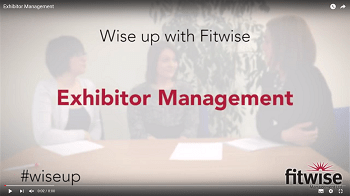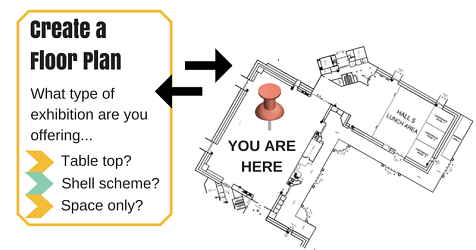
This is our fourth video to our series “Wise up with Fitwise”. To view all our videos visit our YouTube channel or video page of our website.

Exhibitor Management at Healthcare Conferences
To view the video CLICK HERE
To view the infographic CLICK HERE

Here are some tips we have to manage a successful exhibition.

The Exhibition
Not all conferences have an exhibition but if they do it forms a vital part of the conference. Often the exhibitors can fund large aspects of the event so you need to take care of these supporters. The exhibition also gives delegates access to the latest technology and an opportunity to link in with suppliers and network.
Things to consider when running an exhibition
The first place to start with an exhibition is with a floor plan. Not all conferences have a floor plan but it is a useful tool to ensure that all stands fit in the room and it also enables exhibitors to pick their preferred place within the room. Smaller exhibitions tend to have table top stands and larger events can have shell scheme stands which a contractor will construct for you.
You can ask the venue to supply you with a blank floor plan for you to work with. It is important to send your own floor plan back to the venue to ensure they agree with the layout. Sometimes the venues may be able to provide you with a basic exhibition layout plan which you can adapt.
Make sure there is access to electrical points and what the unloading access is like for exhibitors. If the exhibition is in the same room as the sessions, add in breakdown time in between sessions as not to disturb the sessions.
You need to consider the flow of the delegates at larger events with shell schemes in place. This can be done by strategically placing catering, seating and water points to draw delegates into the far corners of the exhibition.
Another way to ensure the flow of delegates is by running a stand competition so that delegates travel around the stands collecting stamps, signatures or answers to questions to be in with a chance of winning a prize.
If there are poster displays and walks, make sure they are in a quieter part of the exhibition so delegates can hear the authors speaking. This will not only help draw traffic into the exhibition, but ensure flow to the far corners of the room.

The Exhibitor Prospectus
What documents do you need to prepare prior to launch?
An exhibitor prospectus is a document containing all the information your exhibitor will need prior to deciding if they actually want to exhibit at your event. This incorporates:
- The stand price
- Inclusive stand items such as tables and chairs, access to electrics etc
- Whether they are able to attend sessions (this is determined on the size of session rooms)
- Sponsorship opportunities: logo on delegate bag and inserts, etc.
- Location of venue: Whether they can access it easily and if it is cost effective to attend.
- Wi-Fi, free parking, etc.
- How they would go about booking
A booking form should be accompanied with the prospectus and should clearly outline the terms and conditions, such as cancelations, charges, etc. Included within the questions on the booking form should be the company’s name and contact details and whether there is anyone else in the company responsible after the stand is booked so you know who to send further information to.
Ensure you allow exhibitors the opportunity to reserve stands, 7 days is fairly standard, so they can get together the necessary paperwork and purchase orders and management signoff to attend.
It is very important to log all exhibitor booking information somewhere, typically an excel spreadsheet serves this purpose well. Spreadsheet columns include: company name, contact details, stand number, stand size, price and notes for any other information.

Exhibitor Liaison
Typically there is one person or a group of people in charge of selling exhibition space. Once an exhibitor has booked a stand the communication then falls to the person managing the logistics of the event, usually an Event Manager. The sales person should ensure the Event Manager is aware of the booking and can start further communication with the exhibitor and continue to liaise with them in the lead up to an event. The Event Manager communication can include things such as deadline dates, editorial for handbooks or online information, logos for main sponsors, and any sign off required if their logo goes on any material.

It is important to chase exhibitors for incomplete information and make sure they know what is expected of them onsite, i.e. arrival and departure times, loading into venue, etc.
Other important information exhibitors should be provided with include:
- How many staff they are allowed to have on the stand? If extra sales reps are present you may wish to charge them to cover the extra cost of the catering.
- Demographic of delegates attending so they can provide the right material.
- Attendee numbers
- Delivery address and times: where to send packages and how they should be marked. Supply them with a delivery label template to ensure they get to the right address on time.
